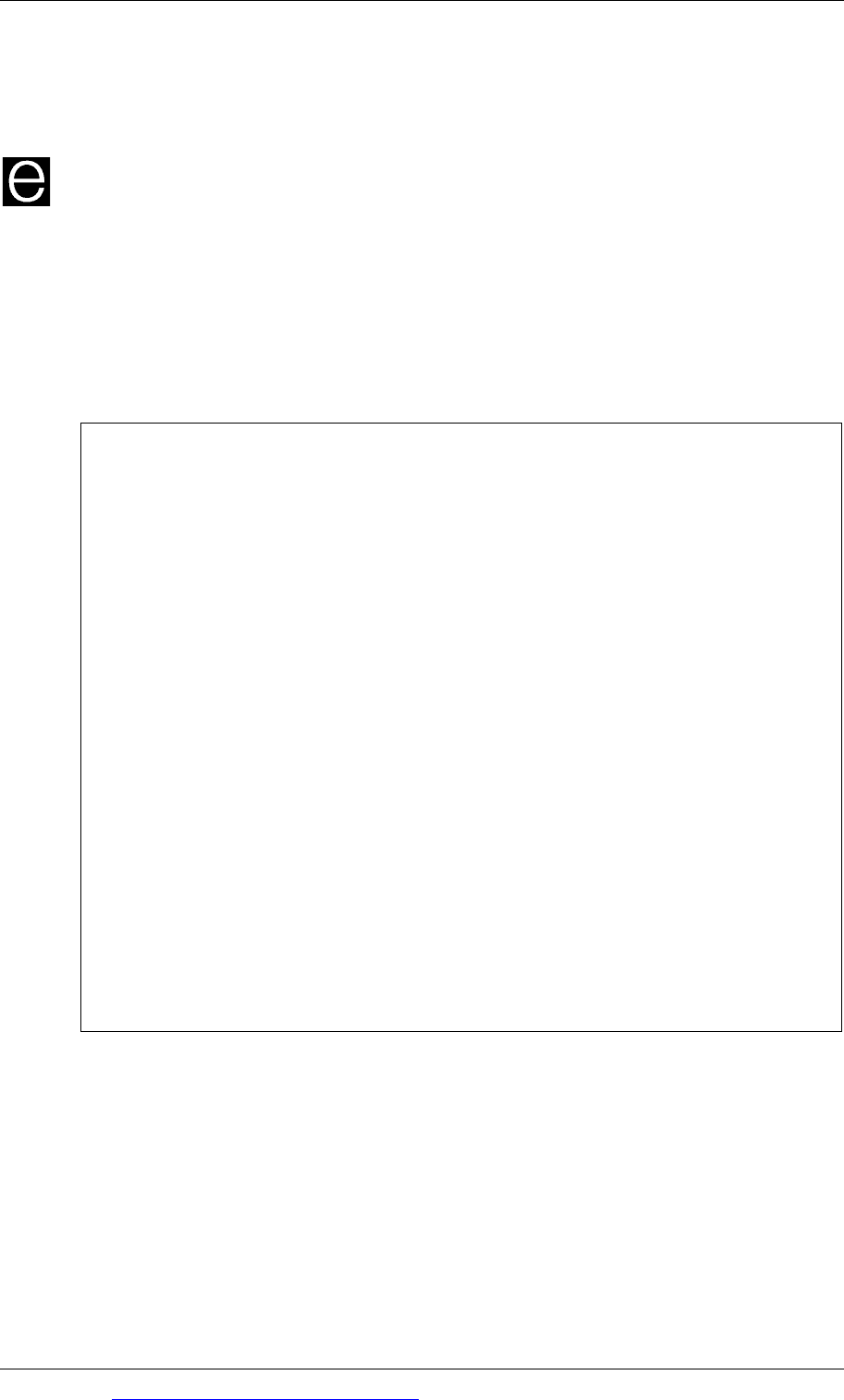ACCA F8 (INT) Audit & Assurance - 2010 - Study text - Emile Woolf Publishing
Подождите немного. Документ загружается.


Chapter 13: Substantive testing: other current assets
© EWP Go to www.emilewoolfpublishing.com for Q/As, Notes & Study Guides 285
Decide on the number of customer balances to be confirmed. The confirmation
process is normally based on a sampling approach. There are often many
customers and the time and effort required to obtain a confirmation from all of
them is not worth the benefit obtained. The auditor should be able to reach a
reasonable conclusion from a representative sample of accounts.
Decide on the confirmation method to be used. This will be a positive or
negative confirmation request. These methods are explained below.
1.4 Positive or negative confirmation?
The confirmation will be either positive or negative. The auditor should decide
which type of confirmation to obtain.
Positive confirmation
A positive confirmation request asks the customer to reply to the auditor whether
or not he agrees with the balance on his account that is in the client company’s
accounting records (receivables ledger) as at the date selected for the confirmation.
Positive confirmation can be obtained in either of two ways:
Method 1. By providing the customer with details of the balance on his account,
and asking him to indicate his agreement that this information is correct, or to
indicate that it is wrong.
Method 2. By asking the respondent to provide details of his balance at the
selected date, but not providing any details of the balance in the client
company’s receivables ledger.
This should provide reliable audit evidence. However, there is a risk with Method 1
that a customer may reply to a confirmation request without checking that the
information is correct. This risk can be reduced by using Method 2. However, with
Method 2 there may be a lower response rate from customers, because they are
being asked to do more work to provide the confirmation.
Negative confirmation
A negative confirmation request asks the customer to reply to the auditor only
where he disagrees with the balance recorded by the company. If no reply is
received, there is no explicit audit evidence in respect of the customer’s balance. The
absence of a reply could mean that the customer agrees with the balance, but is not
required to provide written evidence. On the other hand, the absence of a reply
could mean that the customer has not carried out any check of the balance at all.
The use of negative confirmation requests therefore provides audit evidence that is
less reliable than evidence obtained with positive confirmation requests.
ISA 505 only permits the sole use of negative confirmation where all of the
following conditions are met:
The risk of material misstatement has been assessed as low and controls have
been tested.
The population is comprised of a large number of small account balances or
transactions.

Paper F8: Audit and assurance (International)
286 Go to www.emilewoolfpublishing.com for Q/As, Notes & Study Guides © EWP
A very low exception rate is expected.
The auditor is not aware of circumstances which would case the respondent to
ignore his request for confirmation.
Example: request for a confirmation of balance (positive confirmation)
A sample letter to a customer asking for confirmation of the outstanding balance,
using the positive confirmation method, is shown below.
Note that it appears to be written by the management of the client company. In
practice, this provides authorisation for the customer to provide the required
information direct to the auditor. As discussed above, the letter will also be sent out
to customers by the auditor (to make sure that the letters are actually sent to the
customers in the selected sample). Replies should go directly to the auditor.
A COMPANY
25 South Street
Anytown
Customer’s name and address
Date ………...…….
Dear …………….…
In accordance with the request of our auditors, Arthur Dailey and Co we ask that you kindly
confirm to them directly your indebtedness to us at (insert date) which, according to our
records, amounted to $………..…. as shown by the enclosed statement.
If the above amount is in agreement with your records, please sign in the space provided below
and return this letter direct to our auditors in the enclosed stamped addressed envelope.
If the amount is not in agreement with your records, please notify our auditors directly of the
amount shown by your records, and if possible detail on the reverse of this letter full particulars
of the difference.
Yours faithfully,
A COMPANY
Confirmation No ……………
The amount shown above is/is not* in agreement with our records as at ………………….
Account No …………………………….… Signature ………………………….……………………
Date ………………………………….……….
Title or position …………………….……….
* the position according to our records is attached
1.5 Sample selection and performing the confirmation exercise
The auditor will normally select a sample of customers who will be asked to provide
a confirmation of the balance on their account with the client company. The audit
procedures for selecting the sample and for the confirmation process are as follows:
Obtain or prepare an aged listing of receivables ledger balances at the chosen
date.
If the list is prepared by the client, check the completeness and accuracy of the
list of balances and the total of the balances in the list. This can be done by
checking the list against (1) the total balance for trade receivables in the

Chapter 13: Substantive testing: other current assets
© EWP Go to www.emilewoolfpublishing.com for Q/As, Notes & Study Guides 287
receivables control account in the main ledger and (2) a sample of customers’
account balances in the receivables ledger.
A suitable sampling method should be chosen. As with all sampling, the sample
selection process should as far as possible ensure that the sample is
representative of the ‘population’ of receivables.
If the ‘population’ of receivables ledger balances is not homogeneous, stratified
sampling might be used. (Stratified sampling was explained in an earlier
chapter.)
In selecting the sample, certain types of account should be considered for
inclusion:
− Overdue accounts
− Credit balances or ‘negative balances’ (accounts where the client entity owes
money to its customer, having issued credit notes to the customer)
− Accounts on which round sum payments are received (for example, where
the customer makes payments of $500, or $1,000 or $3,000, instead of paying
specific invoices)
− Nil balances. (A check on nil balances provides a check on the completeness
of trade receivables.)
− Any individual balances that are considered ‘material’.
In an IT system, with many year-end receivables balances audit software can be
used to help select the main sample (for by selecting every 500th $ for sampling
or selecting all balances over a certain amount, as well as nil and credit
balances).
Having selected items for circularisation, details should be extracted from the
receivables ledger, and letters to the customer should be prepared.
In the case of an external audit, the confirmation requests are issued by the
auditor, not by the client, and replies are sent directly to the auditor. However,
the request will need to contain management’s authorisation to the customer to
disclose the necessary information. Should the client refuse to give permission
for a confirmation letter to be sent to a particular customer, the auditor should
look for a reason for the refusal. As that customer has been included in the
sample selection, the auditor will need to carry out alternative audit work (see
below) to verify that customer balance.
The letters should be sent out by post.
With positive confirmation requests, if the auditor does not receive a reply from
a customer within a reasonable period of time, follow-up procedures should be
initiated. For example, second request and third request letters could be sent, or
the client could be asked to contact the customer and ask for a reply.
1.6 Audit procedures following the receipt of replies (with positive
confirmation requests)
On receipt of the replies from customers, the auditor should check that the letters
are signed by a responsible official. The replies are filed in the receivables section of
the current audit file. The current audit file should classify the customers in the
sample as follows:

Paper F8: Audit and assurance (International)
288 Go to www.emilewoolfpublishing.com for Q/As, Notes & Study Guides © EWP
Balance agreed. The customer has replied and agrees with the balance in the
client entity’s accounting records (or has provided a balance that corresponds
with the entity’s accounting records – depending on whether Method 1 or
Method 2 of positive confirmation is used). No further audit work is required.
Balance not agreed. The customer has replied but does not agree with the
balance in the client entity’s accounting records. The auditor should ask the
client to review the replies and try to reconcile the balance in their records with
the balance confirmed by the customer. The auditor should then check the
reconciliation, looking for evidence of errors in the client company’s figures
which may represent misstatements of their accounts receivable balances.
However, many of the reconciling items will often be ‘timing differences’ –
invoices, credit notes or cash may be recorded in the accounts of one party (the
customer or the client entity), but not yet recorded by the other. Provided that
the auditor is confident that the difference in the balances is due to timing
differences, they should not be seen as evidence of errors in receivables balances.
No reply received. No reply has been received from the customer. The auditor
cannot ignore these customer accounts. They have been chosen as part of a
representative sample and the auditor needs to reach a conclusion on the
accuracy of the balances on all the accounts included in the sample for the
confirmation process.
Further checking where no reply is received
Where no reply has been received, the auditor should therefore perform alternative
procedures in order to obtain evidence to confirm the customer’s balance.
If the customer has subsequently paid all of the amount due at the confirmation
date, this is strong evidence of the validity of the debt.
If no payment (or only part-payment) has been received, all the relevant
documentation supporting the amount still due should be examined. For each
invoice outstanding at the confirmation date, the auditor should examine:
− a signed customer purchase order
− signed delivery documentation (the customer’s signature on the delivery
note)
− a sales invoice addressed to the customer.
1.7 Preparing a summary and reaching a conclusion
On completion of the confirmation exercise, the auditor should produce a summary
of the responses. This should clearly indicate the amounts of the balances subject to
confirmation for which the auditor has not been able to establish supporting
evidence. These amounts indicate misstatement of receivables balances. In
particular, they may indicate the existence of bad debts.
As always with a sampling exercise, the auditor should draw a conclusion on the
likely level of misstatement in the total population of receivables balances based on
the result of the sample, and whether this is material.
Such a summary might be prepared as follows:

Chapter 13: Substantive testing: other current assets
© EWP Go to www.emilewoolfpublishing.com for Q/As, Notes & Study Guides 289
Value of balances % of total
$
Replies received and agreed 465,600 80.3
Replies received and reconciled 56,400 9.7
Non-replies agreed using alternative procedures 43,200 7.5
Balances still unresolved 14,300 2.5
–––––––––––––––––––––––––––––––––––
–
–
–
–––
–
––––––––––––––––
––
579,500 100
–––––––––––––––––––––––––––––––––––
–
–––––
–
–––––––––––––––––
––
Total value of receivables = $1,248,900.
Extrapolation of potential error = $1,248,900 × 2.5% = $31,222 – Transferred to the
cumulative errors schedule
Note: The cumulative errors schedule is a list of items where the auditor’s view of
the amount of the item differs from the amount in the client company’s accounting
records/draft financial statements. The auditor builds up this schedule as the audit
progresses, and will use it when reaching his final audit opinion.
1.8 Other audit procedures for trade receivables
In addition to the confirmation process, the auditor should consider the following
additional audit procedures in respect of trade receivables:
Bad debts
The auditor needs to be satisfied that the amount of bad debts written off and any
allowance made for doubtful debts are reliable. These will affect the amount
included in the statement of financial position for trade receivables. The following
substantive procedures should therefore be performed:
Review the company’s procedures for identifying bad and doubtful debts.
Review aged listings of receivables balances (‘aged debtors lists’). Bad debts and
allowances for doubtful debts should only relate to overdue accounts. The
auditor should enquire as to whether the overdue debts are collectable.
Review any correspondence of the client company with customers, lawyers and
collection agencies that deal with unpaid debts or disputed debts.
Review the calculation of any allowances against doubtful debts.
Examine credit notes issued after the year-end, as evidence that some balances
were overstated at the year-end. (The customer and the client company may
have been in dispute about an invoice at the end of the financial year, and the
dispute may subsequently have been resolved by the issue of a credit note and a
reduction in the amount receivable.)
Review the replies from customers for the confirmation of balances exercise, for
evidence of debts that may not be collectable.
Cut-off
The audit work after the physical inventory count will also give evidence of the
accuracy of sales cut-off. The cut-off assertion was explained in an earlier chapter. It
is concerned with ensuring that revenue (and therefore receivables) are properly

Paper F8: Audit and assurance (International)
290 Go to www.emilewoolfpublishing.com for Q/As, Notes & Study Guides © EWP
recorded in the correct accounting period. Sales that occur just before or after the
year-end need to be allocated to the correct financial year.
Additional work on this area might include the following:
The use of analytical procedures to confirm that inventory levels, cost of sales
and gross margins can be explained in terms of known business facts.
Checking that sales invoices and credit notes dated shortly before and after the
year end are recorded in the correct financial year.
Review of the control account entries shortly before and after the year end for
unusual items, which the client should then be asked to explain.
Presentation and disclosure
To satisfy the presentation and disclosure assertion the auditor will need to ensure
that:
the list of receivables ledger balances (on which he bases his substantive
procedures below) agrees to the financial statements
receivables are correctly disclosed and classified in the financial statements.
Example
The following is a summary of the year-end receivables balances at Mike’s
Manufacturing and the equivalent figures for the previous year. Performance
materiality has been set at $5,000.
Customer 20X6 20X5
$ $
Jones 2,500 2,400
Smith 6,000 3,000
Brown 2,000 2,000
White 1,000 1,100
Crane 20,500 18,900
Other customers, all with balances under $1,000 16,600 7,400
–––––––––––––––––––––––––––––––––––
–––––––––––––––––––––––––––––––––––
48,600 34,800
–––––––––––––––––––––––––––––––––––
–––––––––––––––––––––––––––––––––––
Brown went into liquidation during the year.
Required
Set out which of the above balances, as a minimum, the auditor should select for
testing and explain why.
Answer
Smith should be selected as this balance is above performance materiality
threshold. Also, the balance has doubled since the previous year.

Chapter 13: Substantive testing: other current assets
© EWP Go to www.emilewoolfpublishing.com for Q/As, Notes & Study Guides 291
Brown should probably be selected. Although it is below performance materiality
it would seem likely that the debt is bad.
Crane should be selected as individually material.
Although the “other customers” balances all fall well within the performance
materiality threshold, they are material in total, and so a sample of these should
be verified. This would particularly be the case if the auditor was not expecting
sales to smaller customers to have increased during the year. There could be a
deliberate attempt to overstate a number of small balances (or invent fictitious
customers and balances) in a deliberate attempt to boost assets and avoid audit
detection.
1.9 The audit of prepayments
Prepaid expenses are often estimated amounts and so may not be open to precise
and specific audit checking procedures. The problem of auditing accounting
estimates was discussed in a previous chapter. In addition, for many business
entities, prepayments are not material and so may not justify significant audit
attention.
Substantive procedures on prepayments may include the following:
Obtain or prepare a list of prepayments with supporting calculations.
Check the calculations if the list has been prepared by the client’s staff.
Apply analytical procedures (for example, by comparing the balances for
prepayments with the balances at the end of the previous financial year).
Review the list of prepayments for any obvious errors or omissions, based on the
auditor’s knowledge of the business.

Paper F8: Audit and assurance (International)
292 Go to www.emilewoolfpublishing.com for Q/As, Notes & Study Guides © EWP
Substantive procedures: bank and cash balances
Features of the audit of bank and cash balances
Bank balances: confirmation of balances
Audit work on receipt of the banks’ replies
Cash balances: physical count
2 Substantive procedures: bank and cash balances
2.1 Features of the audit of bank and cash balances
For the purpose of this chapter, bank balances are amounts held in a bank account,
and cash balances are bank notes and coins (although coins are likely to be
immaterial).
Assets held as bank balances and cash can be at risk of loss. There may be
fraudulent activity, or the misappropriation of money by employees or others,
particularly when many individuals have authority for dealing with receipts and
payments.
However, bank balances and cash are also easily checked and verified. Bank
balances can be confirmed directly in writing by the banks (third parties) and cash
can be physically counted.
Bank balances and cash are also usually subject to rigorous internal controls, to
prevent loss and theft. In many countries, it is regular practice for business entities
to receive regular bank statements from their bank. A feature of internal control for
bank balances is the reconciliation of the balance shown in a bank statement with
the balance recorded in the entity’s own accounting records (cash book).
The audit work on cash balances will be determined largely by materiality (how
much cash does the entity hold and is it a material amount?) and the effectiveness of
the client’s internal controls for cash.
The principal risks of misstatement of the bank and cash balances in the financial
statements are that:
not all bank balances owned by the client are disclosed (the rights and
obligations and existence assertions)
reconciliation differences between bank statements and the client’s cash book
balances are incorrectly dealt with (the valuation assertion)
material cash balances are omitted (the completeness assertion).
The presentation and disclosure assertion is low risk as the disclosures in this area
are straightforward.

Chapter 13: Substantive testing: other current assets
© EWP Go to www.emilewoolfpublishing.com for Q/As, Notes & Study Guides 293
2.2 Bank balances: confirmation of balances
Checking the accuracy of bank balances can be done effectively by means of direct
confirmation to the auditor by the banks at which the entity’s bank accounts are
held. This is similar to written confirmation of balances from customers, in order to
check trade receivables. The procedures described below are in line with those
described in IAPS 1000 Inter-bank confirmation procedures which applies to
confirmations between banks.
The bank confirmation letter
The auditor must decide which banks to contact for confirmation. Typically, all
banks that hold accounts for the client entity are contacted. However, the auditor
may choose to omit some banks for reasons of immateriality.
The auditor can use either of two possible approaches to the confirmation of bank
balances:
Method 1. The auditor lists information about the bank balances from the
client’s accounting records and asks each bank to confirm that the balances are
correct. (Note: Banks may operate several different accounts for the same
customer.)
Method 2. The auditor requests confirmation of the relevant bank balance(s)
without providing any details to the bank. This method provides stronger audit
evidence but it may be more time-consuming for the bank to provide the
required confirmation.
The two methods are similar to the two methods of positive confirmation of
balances from customers for trade receivables.
In the case of the external audit, permission must be given to the bank by the client
to release information to the auditor. The letter should be written in a standard form
that is acceptable to banks and should include the client entity’s authorisation to the
bank to release the information to the auditor. (The client entity may give standing
authority to the bank to release the information to the auditor each year: if so, the
letter should refer to this standing authority.) The letter should be sent by the
auditor to the bank.
The reply should be sent by the bank direct to the auditor. (This is also the same as
for the confirmation of balances from customers for trade receivables.)
Typical areas covered by the confirmation letter include the following:
Confirmation of balances on all bank accounts at the end of the reporting period.
Details of any unpaid bank charges.
Details of any liens (charges) over assets of the client entity.
Details of any assets of the client entity held by the bank as security for lending.
Details of any other client bank accounts that are known to the bank but not
listed in the request to the bank for confirmation of balances.

Paper F8: Audit and assurance (International)
294 Go to www.emilewoolfpublishing.com for Q/As, Notes & Study Guides © EWP
2.3 Audit work on receipt of the banks’ replies
The main audit work will focus on the confirmation letters from the bank (or the
confirmation letter from the client’s bank, if there is just one bank) and the client
company’s bank reconciliation statement. A statement should be provided by the
bank for the end of the reporting period.
Obtain or prepare a bank reconciliation statement for each bank account.
If the reconciliation is prepared by the company, check it for arithmetical
accuracy.
Check the bank balance confirmed in the bank’s confirmation letter against the
balance used in the bank reconciliation statement.
Relate other information contained in the confirmation letter to other areas of the
audit (for example, accrued bank charges must be provided for in the financial
statements).
Check items appearing in the bank reconciliation statement against any available
supporting evidence (for example, unpresented cheques in the bank
reconciliation statement should be shown as having been presented in a
subsequent bank statement).
Review the cash book and bank statements for unusual items, including unusual
delays between cash book and bank statement entries. Investigate the reasons for
any unusual item.
Review the confirmation letter from the bank for any other information to be
disclosed in the financial statements (for example, charges on assets and security
for loans).
2.4 Cash balances: physical count
The audit work performed on cash balances (as opposed to bank balances) will be
largely dictated by materiality considerations. In this context, materiality should be
considered not only in terms of the statement of financial position amount, but also
in terms of the value of total transactions passing through the cash account during
the period.
In addition, the auditor needs to appreciate that certain businesses hold cash in a
large number of locations (for example, in a company that operates a chain of hotels
or supermarkets). In total, these balances may be material, whereas the amount of
cash held in any single location may be insignificant.
The main audit work involved in verifying cash balances is a physical count.
Audit procedures include the following:
The auditor should count cash at all locations simultaneously and in the
presence of a company official. (Simultaneous counting is necessary, to prevent
the client from moving cash that has been counted at one location to another
location ready for the next count.)
After the count the auditor should obtain a signed receipt for the amount of cash
returned to the official,.
